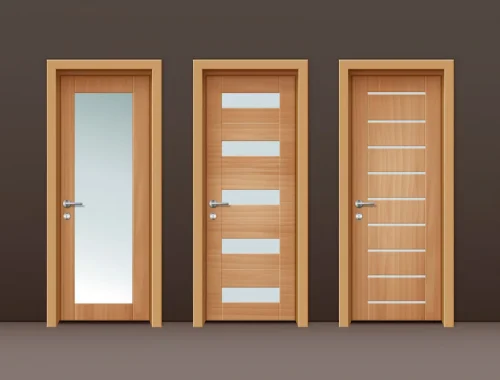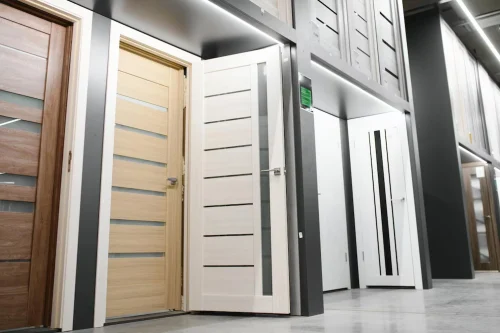
Kitchen Laminates Design: Stylish and Functional Ideas for Your Cooking Space
April 9, 2025
Cement Fibre Board Building Material Revolutionizing Modern Construction
April 10, 2025When planning your home’s interior, have you ever thought about how much impact the right door can have? Whether it’s adding a sleek, minimalist look or ensuring privacy, choosing the right type of door matters. And when it comes to modern spaces, flush doors are a top choice.
So, what makes flush doors so popular? They’re simple, smooth, and fit perfectly in almost any style of home. But with so many options available, how do you pick the one that’s right for your space? Should you go for a hollow core or solid core? What’s the best material for durability and sound insulation?
In this guide, we’ll answer all these questions and more. From the types of flush doors to essential tips for choosing the right one, we’ve got you covered. Whether you're renovating or building from scratch, we’ll help you find the perfect door to suit your needs and style. Let's dive in!
What Are Flush Doors?

Flush doors are characterized by their flat, smooth surface, with no raised panels or intricate designs. They are typically made with a solid or hollow core and are finished with a veneer, laminate, or paint. The minimalist design of flush doors makes them perfect for modern interiors, as they blend seamlessly with the walls and don’t distract from the overall décor.
Flush Door Details:
- Flat and Smooth Surface: Ideal for clean, minimalist interiors.
- Versatile Materials: Can be made from plywood, MDF, or solid wood.
Suitable for All Spaces: Often used in bedrooms, bathrooms, and living areas.
Types of Flush Doors

Flush doors come in a variety of styles and materials, each suited to different needs. Here’s a breakdown of the most common flush doors types and where they work best.
Also Read: Top 5 Door Materials for Maximum Home Security
1. Hollow Core Flush Doors
Hollow core flush doors are lightweight and inexpensive, making them a popular choice for interior doors where noise reduction or insulation is less critical. They consist of a wooden frame with a cardboard or honeycomb core, finished with a veneer or laminate.
- Ideal Use: Interior doors, low-traffic areas.
- Pros: Lightweight, affordable, easy to install.
- Cons: Poor sound insulation, less durable.
2. Solid Core Flush Doors
Solid core flush doors are much heavier and more durable than their hollow counterparts. These doors have a solid core made from engineered wood or hardwood, which provides better sound insulation, strength, and durability.
- Ideal Use: High-traffic areas, entryways, and bedrooms.
- Pros: Excellent sound insulation, durable, secure.
- Cons: Heavier, more expensive than hollow core doors.
3. Laminated Flush Doors
Laminated flush doors feature a laminate finish, which makes them resistant to moisture, scratches, and stains. This type of door is often used in spaces like bathrooms and kitchens where durability and resistance to wear are important.
- Ideal Use: Kitchens, bathrooms, and high-moisture areas.
- Pros: Moisture-resistant, durable, easy to clean.
- Cons: May delaminate over time if not well-maintained.
4. Veneered Flush Doors
Veneered flush doors are covered with a thin layer of real wood veneer, giving them the appearance of solid wood doors at a fraction of the cost. They offer the elegance of wood without the high price tag, making them a popular choice for modern interiors.
- Ideal Use: Living rooms, bedrooms, offices.
- Pros: Elegant, cost-effective, customizable.
- Cons: Prone to scratches, requires maintenance.
5. Fire-Rated Flush Doors
Fire-rated flush doors are designed to withstand high temperatures and prevent the spread of fire for a specific period, usually 30 to 60 minutes. These doors are commonly used in commercial buildings but are also essential for safety in residential settings.
- Ideal Use: Commercial spaces, kitchens, garages.
- Pros: Fire-resistant, enhances safety.
- Cons: More expensive, may not suit all interiors.
6. Flush Door with Frame
This type of door comes as a complete unit with a matching frame. The frame is usually made from the same material as the door, creating a seamless look that enhances the minimalist appeal of flush doors.
- Ideal Use: Entryways, bedrooms, and bathrooms.
- Pros: Easy installation, uniform design.
Cons: Requires precise measurements for installation.
Tips for Choosing the Right Flush Door

Choosing the right flush door for your home can be challenging, especially with so many options available. Here are a few tips to help you make the best choice:
1. Consider the Core
The type of core you choose—whether hollow, solid, or fire-rated—depends on your needs. Hollow core flush doors are great for low-traffic areas, while solid core flush doors provide better sound insulation and security for bedrooms and entryways.
2. Match the Material to the Space
If you’re installing a flush door for bathroom, consider moisture-resistant materials like laminate. For living rooms or bedrooms, veneered flush doors can provide a touch of elegance without breaking the bank.
3. Focus on Durability
If durability is a priority, opt for materials like flush solid core doors or fire-rated doors. These options are designed to withstand wear and tear, ensuring your doors last longer.
4. Select the Right Finish
The finish you choose—whether veneer, laminate, or paint—should complement your interior design. A flush door with frame in a sleek, modern finish can elevate the look of your home while also providing practical benefits like moisture resistance or sound insulation.
5. Think About Security
For entryways and rooms where privacy is important, solid core flush doors are a better choice than hollow core doors. These doors are more secure and provide better soundproofing, making them ideal for bedrooms and home offices.
Conclusion
Whether you’re looking for a minimalist, sleek design or focusing on enhancing your home’s security and durability, flush doors are a versatile choice. Understanding the different types of flush doors and their respective advantages can help you make an informed decision.
From flush door solid core options to flush door with frame designs, the variety of styles and materials available ensures you can find the perfect match for your home’s needs.
By following these tips, you’ll be able to select the right flush door type for your space, ensuring both aesthetic appeal and functional benefits.
Secure Your Home with Green Fortune’s Premium uPVC Windows and Doors
At Green Fortune, we offer top-of-the-line uPVC windows and doors that provide the perfect blend of security, durability, and aesthetic appeal. Our products are designed to keep your home safe, energy-efficient, and stylish, all while requiring minimal maintenance.
Choose Green Fortune for premium quality and lasting peace of mind. Transform your space today—explore our range now!
FAQs
- What is the best flush doors material?
The best material for flush doors depends on factors like durability, moisture resistance, and aesthetics. Solid core flush doors offer excellent strength and durability, making them ideal for high-traffic areas. Laminated flush doors are a better choice for bathrooms due to their moisture resistance. - Can flush doors be used for bathrooms?
Yes, flush doors are commonly used for bathrooms, especially laminated or waterproof types. These doors are moisture-resistant, which is crucial for high-humidity areas. They are also easy to clean and maintain, making them ideal for bathroom use. - What is a solid core flush door?
A solid core flush door is built with a solid, durable material inside, like engineered wood or hardwood. This gives it superior strength, soundproofing, and security compared to hollow core doors. Solid core flush doors are ideal for bedrooms and entryways where durability is a priority.








